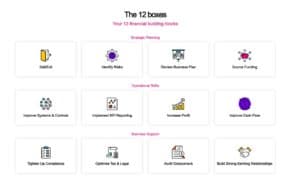The CFO Centre will provide you with a highly experienced senior CFO (Chief Financial Officer) with ‘big business experience’ for a fraction of the cost of a full-time CFO.
This means you will have:
- One of Australia’s leading CFOs, working with you on a part-time basis
- A local support team of CFOs, plus
- A national and international collaborative team of over 750 CFOs sharing best practice (the power of hundreds)
- Access to our national and international network of clients and partners
With all that support and expertise at your fingertips, you will achieve better results, faster. It means you’ll have more confidence and clarity when it comes to decision-making. After all, you’ll have access to expert help and advice whenever you need it.
In particular, your part-time CFO will help you to ensure that your business has planned and prepared for an exit. The sale process would be managed efficiently to minimise challenges on price, and prevent advisors’ fees from absorbing too much of the sale price.
For example, your CFO will:
- Help you to implement your strategy for growth and exit
- Identify where value can be maximised and eliminate unprofitable or low profit activities
- Ensure that shareholders’ interests are protected through a shareholders’ agreement
- Explain what incentive arrangements are available for key management and introduce them. These could include bonus plans aligned to the business objectives or option plans
- Ensure that property is held in the most appropriate manner for the business and any potential acquirer, freehold or leasehold, length of tenancy
- Review pension arrangements to identify any funding or future liability issues
- Review contracts and trading terms to ensure they are in place, up to date and enforced
- Identify risks to the business from suppliers and customers on whom the business may have become reliant and plan to spread the risk
- Improve the accuracy and timeliness of management information
- Introduce systems and controls to increase confidence in the integrity of the accounting information
- Improve and/or introduce forecasting processes and procedures so that budgets and forecasts can be used as dynamic planning tools
- Identify means of improving margins and reducing overheads to improve profitability
- Ensure compliance with PAYG, Superannuation, GST, Income Tax and Company Tax legislation while seeking ways to reduce the overall tax burden to you and your business
- Introduce you to corporate finance, legal and other advisers to help with all aspects of the exit preparation and process
- Project manage the exit process internally so that it minimises the disruption to other staff and their continuing responsibilities
- Create confidence in the acquirer and their advisers so that they have limited opportunity to attempt to negotiate the price down or increase warranties from you
- Help you achieve the freedom you want after the efforts that you have invested in growing business
How much better would you feel when you engage a top calibre CFO to work with you on your exit/succession? Get in touch with us today – 1300 447 740



